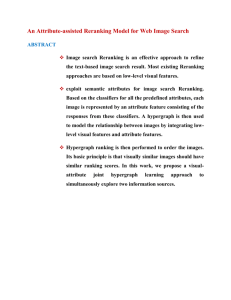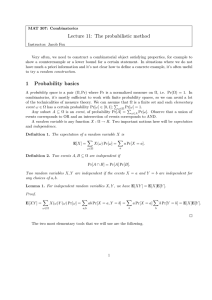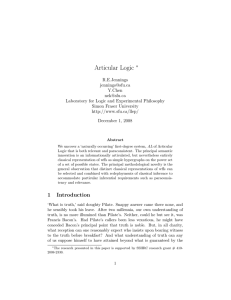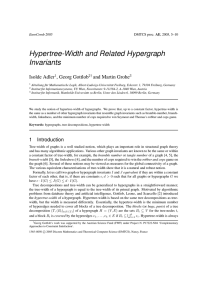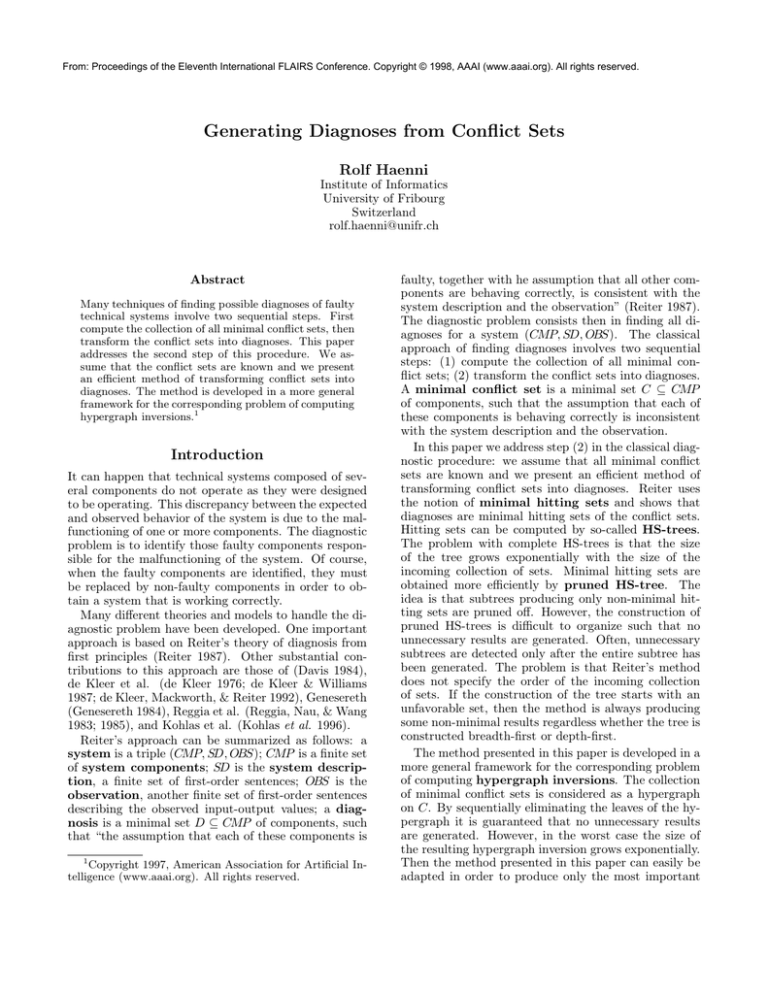
From: Proceedings of the Eleventh International FLAIRS Conference. Copyright © 1998, AAAI (www.aaai.org). All rights reserved.
Generating Diagnoses from Conflict Sets
Rolf Haenni
Institute of Informatics
University of Fribourg
Switzerland
rolf.haenni@unifr.ch
Abstract
Many techniques of finding possible diagnoses of faulty
technical systems involve two sequential steps. First
compute the collection of all minimal conflict sets, then
transform the conflict sets into diagnoses. This paper
addresses the second step of this procedure. We assume that the conflict sets are known and we present
an efficient method of transforming conflict sets into
diagnoses. The method is developed in a more general
framework for the corresponding problem of computing
hypergraph inversions.1
Introduction
It can happen that technical systems composed of several components do not operate as they were designed
to be operating. This discrepancy between the expected
and observed behavior of the system is due to the malfunctioning of one or more components. The diagnostic
problem is to identify those faulty components responsible for the malfunctioning of the system. Of course,
when the faulty components are identified, they must
be replaced by non-faulty components in order to obtain a system that is working correctly.
Many different theories and models to handle the diagnostic problem have been developed. One important
approach is based on Reiter’s theory of diagnosis from
first principles (Reiter 1987). Other substantial contributions to this approach are those of (Davis 1984),
de Kleer et al. (de Kleer 1976; de Kleer & Williams
1987; de Kleer, Mackworth, & Reiter 1992), Genesereth
(Genesereth 1984), Reggia et al. (Reggia, Nau, & Wang
1983; 1985), and Kohlas et al. (Kohlas et al. 1996).
Reiter’s approach can be summarized as follows: a
system is a triple (CMP, SD, OBS); CMP is a finite set
of system components; SD is the system description, a finite set of first-order sentences; OBS is the
observation, another finite set of first-order sentences
describing the observed input-output values; a diagnosis is a minimal set D ⊆ CMP of components, such
that “the assumption that each of these components is
1
Copyright 1997, American Association for Artificial Intelligence (www.aaai.org). All rights reserved.
faulty, together with he assumption that all other components are behaving correctly, is consistent with the
system description and the observation” (Reiter 1987).
The diagnostic problem consists then in finding all diagnoses for a system (CMP, SD, OBS). The classical
approach of finding diagnoses involves two sequential
steps: (1) compute the collection of all minimal conflict sets; (2) transform the conflict sets into diagnoses.
A minimal conflict set is a minimal set C ⊆ CMP
of components, such that the assumption that each of
these components is behaving correctly is inconsistent
with the system description and the observation.
In this paper we address step (2) in the classical diagnostic procedure: we assume that all minimal conflict
sets are known and we present an efficient method of
transforming conflict sets into diagnoses. Reiter uses
the notion of minimal hitting sets and shows that
diagnoses are minimal hitting sets of the conflict sets.
Hitting sets can be computed by so-called HS-trees.
The problem with complete HS-trees is that the size
of the tree grows exponentially with the size of the
incoming collection of sets. Minimal hitting sets are
obtained more efficiently by pruned HS-tree. The
idea is that subtrees producing only non-minimal hitting sets are pruned off. However, the construction of
pruned HS-trees is difficult to organize such that no
unnecessary results are generated. Often, unnecessary
subtrees are detected only after the entire subtree has
been generated. The problem is that Reiter’s method
does not specify the order of the incoming collection
of sets. If the construction of the tree starts with an
unfavorable set, then the method is always producing
some non-minimal results regardless whether the tree is
constructed breadth-first or depth-first.
The method presented in this paper is developed in a
more general framework for the corresponding problem
of computing hypergraph inversions. The collection
of minimal conflict sets is considered as a hypergraph
on C. By sequentially eliminating the leaves of the hypergraph it is guaranteed that no unnecessary results
are generated. However, in the worst case the size of
the resulting hypergraph inversion grows exponentially.
Then the method presented in this paper can easily be
adapted in order to produce only the most important
results. Furthermore, the method can be extended to
solve the problem of transforming CNFs into DNFs and
inversely. In the domain of model-based diagnostics this
is important when the minimal diagnosis hypothesis does not hold (de Kleer, Mackworth, & Reiter 1992).
Note that the problem of computing diagnoses from
minimal conflict sets is also related to the well-known
set covering problem (Cormen, Leiserson, & Rivest
1989). In fact, a diagnosis is a minimal set cover of
the collection of conflict sets. The set covering problem
consists only in finding one solution of minimal size.
The algorithms for solving the set covering problem are
therefore not useful if all diagnoses have to be found.
Hypergraph Inversion
Let N = {n1 , . . . , nr } be a finite set of nodes ni . A
hypergraph H = {e1 , . . . , em } on N is a set of subsets
ei ⊆ N . In other words H ⊆ 2N . The elements of H are
called hyperedges. A hyperedge ei ∈ H is called minimal in H, if there is no other hyperedge ej ∈ H, i 6= j,
such that ej ⊆ ei . A hypergraph is called minimal, if
every hyperedge ei ∈ H is minimal. A hypergraph is
called simple, if H has only one hyperedge. A node
ni ∈ N is called leaf of H, if ni appears only in one
hyperedge.
Hypergraphs can easily be represented graphically.
For example, let
H
=
{{1, 2, 3}, {1, 3, 5}, {1, 6}, {2, 4},
{2, 3, 5}, {2, 4, 5}}
be a hypergraph for N = {1, 2, 3, 4, 5, 6}. This corresponds to Example 4.7 in (Reiter 1987). Figure 1 shows
a graphical representation of H.
2
6
1
4
3
5
Figure 1: A hypergraph representation.
Note that H is not minimal since the hyperedge {2, 4, 5} is not minimal.
A corresponding minimal hypergraph µH can be obtained by
dropping all non-minimal hyperedges.
In this
way {2, 4, 5} can be dropped and we get µH =
{{1, 2, 3}, {1, 3, 5}, {1, 6}, {2, 4}, {2, 3, 5}}.
Furthermore, note that 6 is a leaf of H, whereas 6 and 4 are
leaves of µH.
A set of nodes e ⊆ N is called connecting hyperedge relative to H, if e ∩ ei 6= Ø for all ei ∈ H. For
example, {1, 2} is a connecting hyperedge relative to the
hypergraph in Fig. 1. The set of minimal connecting hyperedges relative to H is called hypergraph inversion
of H, denoted by H −1 . Note that H −1 = (µH)−1 . For
minimal hypergraphs we have the following theorem:
Theorem 1 If H is a minimal hypergraph, then
(H −1 )−1 = H.
(1)
Note that if the elements of H are the (minimal) conflict sets of a faulty technical system, then the elements
of H −1 are the diagnoses. Therefore, the problem of
finding diagnoses from conflict sets corresponds to the
problem of computing hypergraph inversions.
Hypergraph inversions can be computed by sequentially eliminating leaves. Let n ∈ N be a leaf of H and
ei the corresponding hyperedge containing n. Then H
can be decomposed into two other hypergraphs H+n
and H−n in which n does not appear any more:
H+n
H−n
:= µ{ej − ei : ej ∈ H, i 6= j},
:= µ{ej − n : ej ∈ H}.
(2)
(3)
Again, consider the hypergraph H of Fig. 1. Eliminating the leaf 6 leads to H+6 = {{2, 3}, {2, 4}, {3, 5}} and
H−6 = {{1}, {2, 4}, {2, 3, 5}}.
Note that in some cases this procedure may produce
H+n = Ø or H−n = {Ø}. For that purpose let’s define
Ø−1 = {Ø} and {Ø}−1 = Ø. The hypergraph inversion H −1 of H can then be obtained according to the
following theorem:
Theorem 2 If n is a leaf in a hypergraph H, H+n and
H−n as defined in (2) and (3), then
H −1 = {e ∪ {n} : e ∈ (H+n )−1 } ∪ (H−n )−1 .
(4)
Theorem 2 describes a recursive method of computing hypergraph inversions by sequentially eliminating
leaves. The idea is that the minimal connecting hyperedges containing n are determined using H+n , while
the minimal connecting hyperedges not containing n
are obtained from H−n . Note that the solutions generated by H+n and H−n are disjoint in the sense that
the right-hand side of (4) is automatically a minimal
hypergraph. This is the crucial point of this approach:
no unnecessary solutions are generated.
This recursive process can be simplified if instead of
Ø−1 = {Ø} and {Ø}−1 = Ø we use another condition
for simple hypergraphs: let e be the only hyperedge of
a simple hypergraph H = {e}, then
H −1 = {{n} : n ∈ e}.
(5)
The recursive process of computing the hypergraph inversion of above example is depicted in Fig. 2.
The tree shows how the original hypergraph is consecutively decomposed until simple hypergraphs are produced. Finally, the hypergraph inversion is obtained
by (4) and (5). For our example we get the following
solution:
H −1
=
{{1, 2}, {1, 3, 4}, {1, 4, 5}, {2, 3, 6},
{2, 5, 6}, {3, 4, 6}}.
{{1,2,3},{1,3,5},{1,6},{2,4},{2,3,5},{2,4,5}}
+6
-6
{{2,3},{2,4},{3,5}}
+4
{{3}}
{{1},{2,4},{2,3,5}}
-4
+1
{{2},{3,5}}
+2
{{3,5}}
{¯}
-1
{{2,4},{2,3,5}}
-2
+4
{{1,2},{1,3},{2,4},{3,4},{2,5},{4,5}}
{¯}
-4
{{3,5}}
{{2}}
4
Figure 3: A non-regular hypergraph.
Consider an arbitrary node n in a (regular or nonregular) hypergraph H. If En ⊆ H is the set of hyperedges containing n, then a more general decomposition
can be defined:
:= µ{ej − ∩En : ej ∈ H − En },
:= µ{ej − n : ej ∈ H}.
{{2},{3},{4,5}}
Note that both H+n and H−n are regular. To obtain
the hypergraph inversions (H+1 )−1 and (H−1 )−1 we can
therefore use Theorem 2 for regular hypergraphs to get
the following results:
(H+1 )−1
(H−1 )
(6)
(7)
This way of decomposing H replaces (2) and (3) since
it includes the case of n being a leaf by En = {ei }.
For a non-regular hypergraph H we can now obtain the
hypergraph inversion H −1 as follows:
Theorem 3 If n is a node in a hypergraph H, H+n
and H−n as defined in (6) and (7), then
H −1 = µ({e ∪ {n} : e ∈ (H+n )−1 } ∪ (H−n )−1 ). (8)
The only difference between Theorem 2 and Theorem 3
is the necessity of minimizing the result in Theorem 3.
Note that the operation µ can be optimized for this
particular case. If we define H1 := {e ∪ {n} : e ∈
(H+n )−1 } and H2 := (H−n )−1 , then the problem in
Theorem 3 is to compute µ(H1 ∪ H2 ). Clearly, H1 and
−1
=
{{2, 3, 5}, {2, 4}, {4, 5}},
=
{{2, 3, 4}, {2, 3, 5}}.
Finally, we can use Theorem 3 to compute the hypergraph inversion for the example in Fig. 3:
H −1
2
5
H+n
H−n
-1
Figure 4: Decomposing a non-regular hypergraph.
The attentive reader may have recognized that this approach of eliminating leaves is only working if every
hypergraph produced during the recursion has at least
one leaf. A hypergraph with at least one leaf is called
regular. Figure 3 shows a non-regular minimal hypergraph. In such a case the above decomposition is not
applicable.
3
+1
{{2,4},{3,4},{2,5},{4,5}}
Figure 2: Recursive process for computing H −1 .
1
H2 are minimal. Furthermore, every hyperedge in H2
is minimal in H1 . Therefore, we have only to check if
H1 contains hyperedges which are not minimal in H2 .
Let n = 1 be the node to be eliminated from the
example in Fig. 3. The hypergraph can then be decomposed as follows:
=
{{1, 2, 4}, {1, 4, 5}, {2, 3, 4}, {2, 3, 5}.
Note that {2, 3, 5} ∈ (H+1 )−1 is not relevant for the
final result because the same hyperedge is already contained in (H−1 )−1 . Therefore, this example produces
only one unnecessary result, since during the computation of (H+1 )−1 and (H−1 )−1 only regular hypergraphs
arise.
In the domain of model-based diagnostics, i.e. when
H represents the minimal conflict sets for a system
(CMP, SD, OBS), non-regular hypergraphs are rare.
Typically, non-regular hypergraphs are only observed
in less than one percent of the recursive calls. Similar
results are observed in other domains.
This method of computing hypergraph inversions can
be described by the following recursive algorithm:
Algorithm 1 (Hypergraph Inversion)
- Input: hypergraph H
- Output: hypergraph inversion H −1
BEGIN
IF H is simple
THEN RETURN {{n} : n ∈ e, e ∈ H};
ELSE
IF H is regular
THEN SET n := leaf of H;
ELSE SET n := node of H;
ENDIF;
SET H+ according to (6);
SET H− according to (7);
−1
−1
COMPUTE H+
and H−
recursively;
−1
−1
SET H∗ := {e ∪ {n} : e ∈ H+
} ∪ H−
;
IF H is regular
THEN RETURN H∗ ;
ELSE RETURN µH∗ ;
ENDIF;
ENDIF;
END.
A leaf can easily be selected from a hypergraph. The
following algorithm determines the set L of all leaves of
a hypergraph H. Note that H is regular if and only if
L 6= Ø.
Algorithm 2 (Computing Leaves)
- Input: hypergraph H
- Output: set L of all leaves of H
BEGIN
SET L := Ø;
SET N := Ø;
LOOP FOR e in H DO
SET L := (L − e) ∪ (e − N );
SET N := N ∪ e;
ENDLOOP;
RETURN L;
END.
Actually, every leaf n ∈ L can be selected for being eliminated from a regular hypergraph H. However, let’s remarks that Theorem 2 and Alg. 1 can easily be adapted
such that leaves from the same hyperedge can be eliminated simultaneously. Then it is recommendable to
select the leaves of the hyperedge with a maximal number of leaves. This reduces the necessary number of
calling Alg. 2 recursively.
Similarly, every node n ∈ N can be selected for being
eliminated from a non-regular hypergraph H. Here it
is recommendable to select a node n such that the size
of En is maximal. This ensures that the size of H − En
is minimal and therefore that H+n in (6) is as small
as possible. This reduces the number of unnecessary
results generated by (H+n )−1 .
Let s be the number of resulting hyperedges in H −1
and let’s assume that computing H −1 produces only
regular hypergraphs. If we neglect the time needed for
selecting a leaf in a hypergraph by Alg. 2 as well as the
cost of decomposing the hypergraph according to (6)
and (7), then the time needed for computing H −1 by
Alg. 1 grows linearly with s. Of course, s itself may
grow exponentially with the number of hyperedges in
H, for example in the case when H consists only of
leaves (worst case). Then, the complexity lies within
the nature of the problem and Alg. 1 is only feasible, if
the result H −1 consists of a relatively small number s
of connecting hyperedges.
Approximating Hypergraph Inversion
The problem of computing hypergraph inversions is
that the number s of resulting connecting hyperedges
in H −1 grows exponentially with the number of hyperedges in H. However, it may often not be necessary to
know the complete set H −1 . In the domain of modelbased diagnostics, for example, only short diagnoses are
interesting. The idea of more and less important connecting hyperedges will be developed in this section. In
this sense the algorithm of Section will be adapted in
order to approximate hypergraph inversions.
Generating Short Hyperedges
The number of nodes in a hyperedge e is called size
of e, denoted by |e|. If N = {n1 , . . . , nr } is the set
of nodes, then Ek = {e ∈ 2N : |e| ≤ k} denotes the
set of all hyperedges in N with a size smaller than k.
Let H = {e1 , . . . , em } be a hypergraph on N . The
hypergraph inversion of order k can then be defined
by
H −1 (k) = H −1 ∩ Ek .
(9)
−1
Note that we have H (0) = Ø for an arbitrary H 6= Ø.
Furthermore, if m is the number of hyperedges in H and
n ≥ m, then H −1 (n) = H −1 .
Consider the example of Fig. 1. The hypergraph inversions of order k, k = 0, 1, . . . are then
H −1 (0)
H −1 (1)
=
=
Ø,
Ø,
H −1 (2)
=
{{1, 2}},
(3)
=
{{1, 2}, {1, 3, 4}, {1, 4, 5}, {2, 3, 6},
{2, 5, 6}, {3, 4, 6}},
H −1 (4)
=
{{1, 2}, {1, 3, 4}, {1, 4, 5}, {2, 3, 6},
{2, 5, 6}, {3, 4, 6}},
H
−1
..
.
The algorithm of Section can now be adapted for the
computation of H −1 (k). The idea is that at each step of
the recursion the computation of (H+n )−1 starts with
k−1. An additional condition k = 0 stops the recursion.
Algorithm 3 (Hypergraph Inversion of Order k)
- Input: hypergraph H, order k
- Output: hypergraph inversion of order k
BEGIN
IF k = 0
THEN RETURN Ø;
ELSE
IF H is simple
THEN RETURN {{n} : n ∈ e, e ∈ H};
ELSE
IF H is regular
THEN SET n := leaf of H;
ELSE SET n := node of H;
ENDIF;
SET H+ according to (6);
SET H− according to (7);
−1
−1
COMPUTE H+
(k − 1) and H−
(k) recursively;
−1
−1
SET H∗ := {e ∪ {n} : e ∈ H+
(k − 1)} ∪ H−
(k);
IF H is regular
THEN RETURN H∗ ;
ELSE RETURN µH∗ ;
ENDIF;
ENDIF;
ENDIF;
END.
With this algorithm it is now possible to compute
the shortest connecting hyperedges even for big hypergraphs. However, the worst case (i.e. if H only consists
of leaves) is still not feasible because the hyperedges of
H −1 have all the same size. In such cases the method
of the following subsection may help to obtain the most
relevant results.
Generating Relevant Hyperedges
In this subsection we develop the idea that some nodes
of the hypergraph are more important than others.
Therefore, connecting hyperedges consisting of more
important nodes are more relevant than hyperedges
consisting of less important nodes. Suppose that for
each node ni ∈ N a corresponding relevance factor
0 ≤ p(ni ) ≤ 1 is given. In the sequel, relevance factors
are treated as probabilities. The relevance p(e) of a
hyperedge is then given by the product of the relevance
factors of the nodes in e:
Y
p(e) =
{p(ni ) : ni ∈ e}.
(10)
Note that in most cases the shortest hyperedges are also
the most relevant hyperedges. If p is a number between
0 and 1, then Ep = {e ∈ 2N : p(e) ≥ p} denotes the
set of all hyperedges in N with a relevance higher than
p. Let H = {e1 , . . . , em } be a hypergraph on N . The
hypergraph inversion of relevance p can then be
defined by
H −1 (p) = H −1 ∩ Ep .
(11)
Again, consider the example of Fig. 1. Suppose that
the following relevance factors are given: p(1) = 0.9,
p(2) = 0.8, p(3) = 0.7, p(4) = 0.6, p(5) = 0.5, and
p(6) = 0.4. The relevance of the connecting hyperedges
in H −1 is then given by the following values:
p({1, 2}) = 0.72, p({1, 3, 4}) = 0.378,
p({1, 4, 5}) = 0.27, p({2, 3, 6}) = 0.224,
p({3, 4, 6}) = 0.168, p({2, 5, 6}) = 0.16.
For example, if we fix p = 0.25, then the hypergraph
inversion of relevance 0.25 is
H −1 (0.25)
= {{1, 2}, {1, 3, 4}, {1, 4, 5}}.
Again, the algorithm of Section can easily be adapted
for the computation of H −1 (p). The idea now is that at
each step of the recursion the computation of (H+n )−1
p
starts with p(n)
. An additional condition p > 1 stops
the recursion.
Algorithm 4 (Hypergraph Inversion of Relevance p)
- Input: hypergraph H, relevance p
- Output: hypergraph inversion of relevance p
BEGIN
IF p > 1
THEN RETURN Ø;
ELSE
IF H is simple
THEN RETURN {{n} : n ∈ e, e ∈ H};
ELSE
IF H is regular
THEN SET n := leaf of H;
ELSE SET n := node of H;
ENDIF;
SET H+ according to (6);
SET H− according to (7);
p
−1
−1
COMPUTE H+
( p(n)
) and H−
(p) recursively;
−1
−1
(k);
SET H∗ := {e ∪ {n} : e ∈ H+ (k − 1)} ∪ H−
IF H is regular
THEN RETURN H∗ ;
ELSE RETURN µH∗ ;
ENDIF;
ENDIF;
ENDIF;
END.
With this algorithm it is now possible to compute the
most relevant connecting hyperedges even in the worst
case when H only consists of leaves. The only case
in which the algorithm is still not able to produce any
result is when H consists only of leaves and when all
the nodes ni ∈ N have the same relevance factors (the
worst case of the worst case).
Acknowledgments
Research supported by grant No.2100–042927.95 of the
Swiss National Foundation for Research.
References
Cormen, T.; Leiserson, C.; and Rivest, R. 1989. Introduction to Algorithms. MIT Press.
Davis, R. 1984. Diagnostic reasoning based on structure and behaviour. Artificial Intelligence 24:347–410.
de Kleer, J., and Williams, B. 1987. Diagnosing multiple faults. Artificial Intelligence 32:97–130.
de Kleer, J.; Mackworth, A. K.; and Reiter, R. 1992.
Characterizing diagnosis and systems. Artificial Intelligence 56:197–222.
de Kleer, J. 1976. Local Methods for Localizing Faults
in Electronical Circuits. MIT AI Memo 394, MIT
Cambridge, MA.
Genesereth, M. 1984. The use of design description
in automated diagnosis. Artificial Intelligence 24:411–
436.
Kohlas, J.; Monney, P.; Anrig, B.; and Haenni,
R. 1996. Model-based diagnostics and probabilistic
assumption-based reasoning. Technical Report 96–09,
University of Fribourg, Institute of Informatics.
Reggia, J.; Nau, D.; and Wang, Y. 1983. Diagnostic
expert systems based on set covering model. Int. J.
Man-Machine Stud. 19:437–460.
Reggia, J.; Nau, D.; and Wang, Y. 1985. A formal
model of diagnostic inference: 1. problem formulation
and decomposition. Inf. Sci. 37:227–256.
Reiter, R. 1987. A theory of diagnosis from first principles. Artificial Intelligence 32:57–95.


